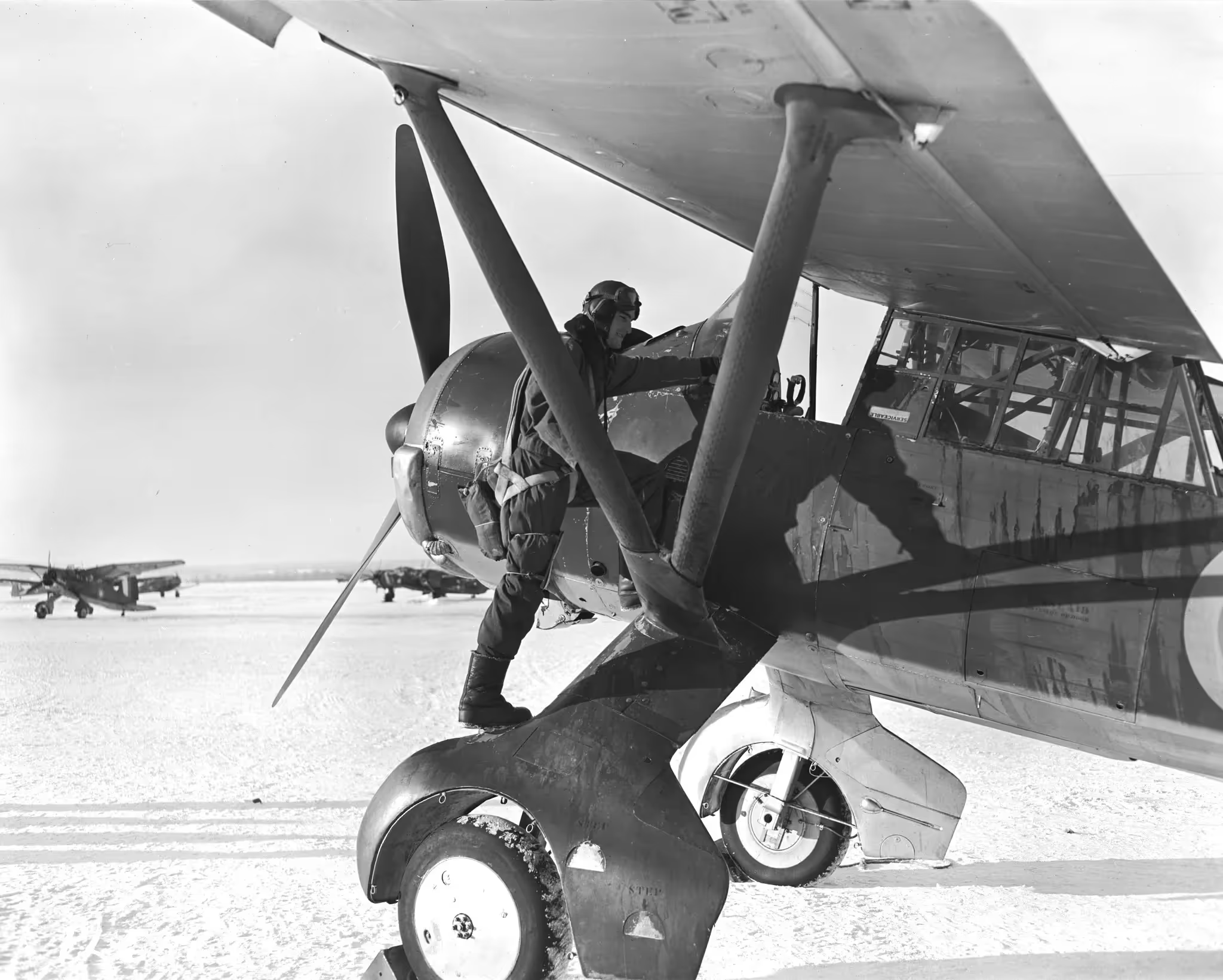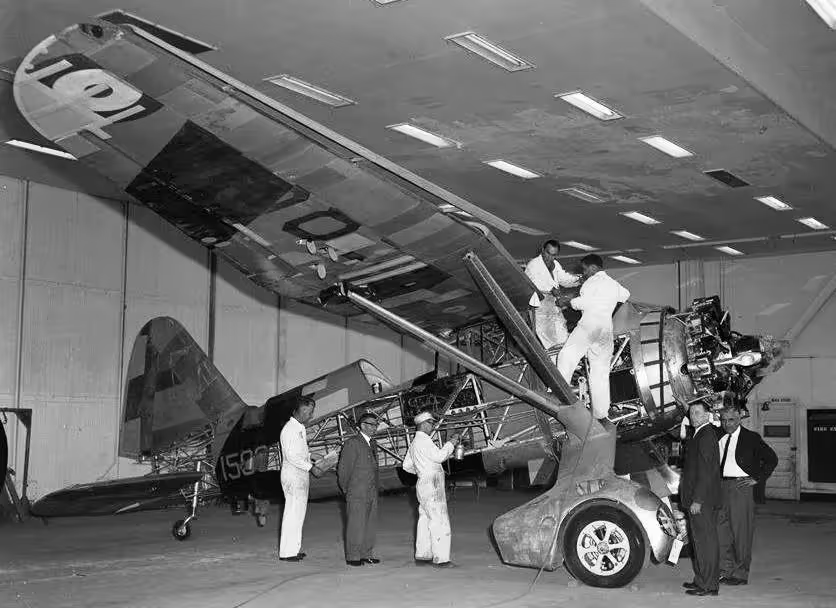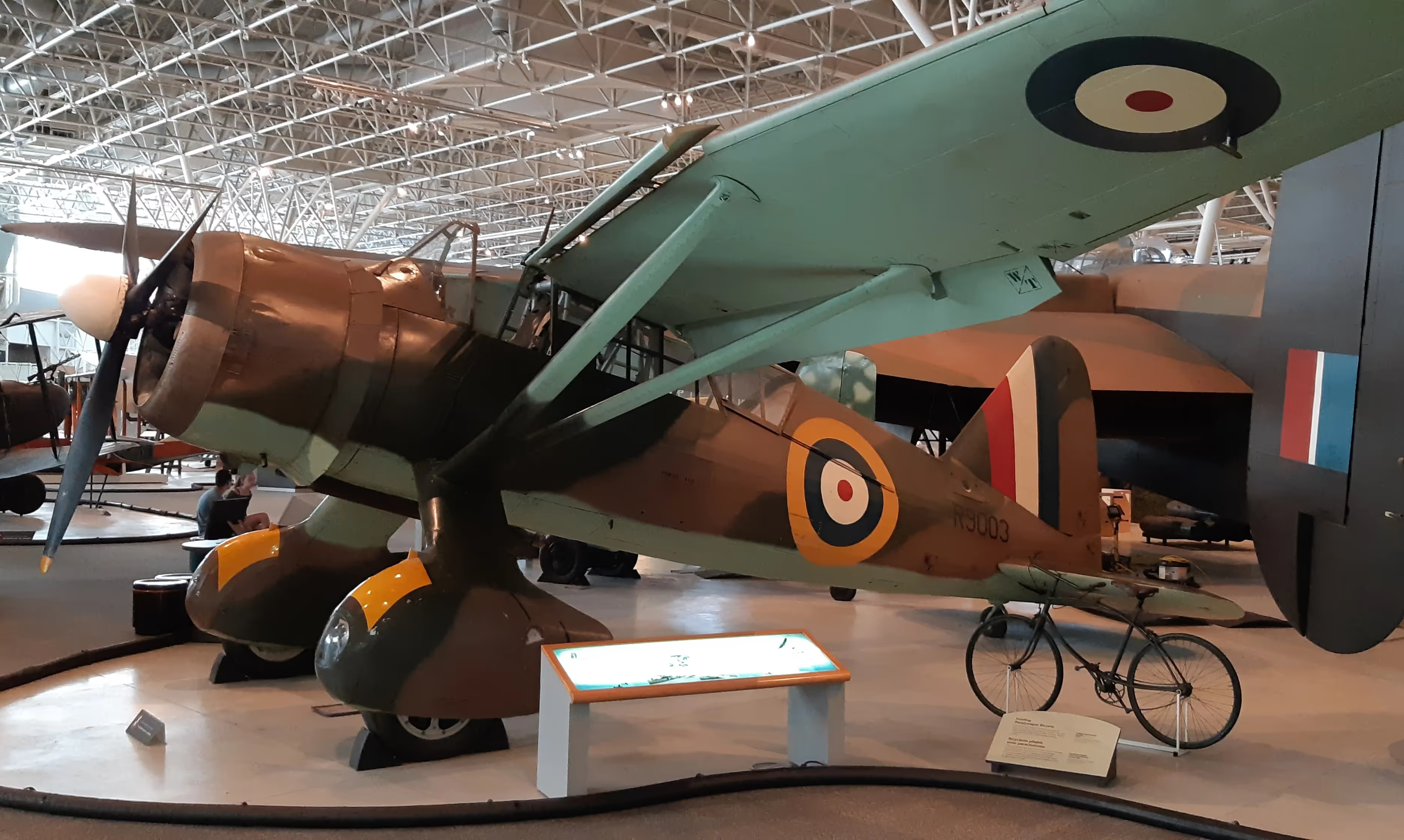Canadian Warplanes 3: Westland Lysander
Westland Lysander

(RCAF Photo)
Westland Lysander Mk. II, RCAF (Serial No. 416), Patricia Bay, 1 Nov 1941. No. 416 was the first Canadian-produced example, joining the RCAF on 7 September 1939.
The Lysander had excellent short take-off and landing (STOL) characteristics. For a brief period in 1940, every available Hawker Hurricane fighter in Canada had been sent overseas to fight in the Battle of Britain. This situation left the RCAF without a modern fighter aircraft at home in Canada. Two RCAF Lysander-equipped squadrons which were supposed to convert to fighter aircraft but had none to convert to, were re-designated as operational fighter squadrons. No. 111 Squadron, a Coastal Artillery Squadron which earlier had replaced its Avro trainers with Lysanders and been reclassified as an Army Co-operation Unit, was again reclassified as a fighter squadron – the only one on the Canadian west coast – in June 1940. Lysander-equipped No. 118 Squadron was also re-designated as a fighter squadron. The Lysander completely lacked the capability to operate in a fighter role, and neither squadron saw action as a fighter unit while equipped with Lysanders, but their designation as fighter squadrons did allow RCAF fighter pilots to work up at a critical time without having to wait for the arrival of true fighter aircraft. No. 118 Squadron was disbanded in September 1940, and when it reformed in December 1940, still as a fighter squadron, it was equipped with 15 obsolete Grumman Goblin fighters produced by Canadian Car and Foundry. Both No. 111 and No. 118 Squadrons soon re-equipped with the Curtiss P-40 Kittyhawk, bringing the brief service of Lysanders in fighter squadrons to an end. The aircraft was invaluable at landing behind enemy lines and rescuing downed pilots, POW or the resistance. (David Lynn Courtney)
Westland Lysander Mk. II (76), (Serial Nos. 416-490, 700), Mk. IIIA (150), (Serial Nos. 2305-2454), Mk. IIIT (103), (Serial Nos. 1536-1592, V9281, V9290, V9301, V9312, V9315, V9318, V9320, V9323, V9324, V9347, V9351, V9365, V9370, V9371, V9378, V9383, V9386, V9407, V9409, V9413, V9417, V9423, V9442, V9443, V9449, V9486, V9502, V9504, V9508, V9519, V9520, V9526, V9553, V9556, V9570, V9577, V9589, V9607, V9642, V9651, V9676, V9678, V9712, V9716, V9733, V9739), for a total of 329 aircraft.

(RCAF Historians Photo, via Francois Dutil)
No. 118 Sqn Lysanders (Serial Nos. 422, 423 and 432) at St-John, New Brunswick, in 1940.

(RCAF Photo via Mike Kaehler)
Pilot Officer McKessock climbs into the cockpit of his plane. On other occasions he might be accompanied by an observer-gunner who would be seated in the rear. The plane's forward guns are carried in the "pants" which cover the wheels.

(City of Vancouver Archives Photo, AM640-S1-: CVA 260-1358)
Westland Lysander Mk. II, RCAF (Serial No. 424), Vancouver, British Columbia, 23 Dec 1939.
While putting together the 1st Infantry Division for service overseas, the Canadian government also prepared a support squadron, No. 110 (Army Co-operation) under Squadron Leader W.D. Van Vliet. The squadron was dispatched to Great Britain in February 1940 with its 12 Westland Lysanders. Pilots and gunners immediately started specialized training at the School of Army Co-operation, near Salisbury, then operational training in Oldham, Hampshire.
On account of their being assigned to the Army Co-operation Command, No. 110 airmen did not take part in the Battle of Britain which was happening under their very eyes from July to October 1940; certainly a frustrating experience for young men eager to fly and fight. It may have been a good thing, though, as the Luftwaffe Messerschmitt Bf 109s would have ripped through their outdated Lysanders. The squadron, on the other hand, was getting ready to support VII Army Corps under LGen McNaughton, which would be facing the German invasion that seemed then to be imminent. The Battle of Britain proved the Luftwaffe was unable to take control of the sky, and Hitler cancelled the invasion, which had been planned for 12 October 1940. Once again, No 110 Squadron was to remain untested. Later on, in March 1941, it became No. 400 (Army Co-operation) Squadron and was equipped with Curtiss Tomahawk fighters.
When dispatched overseas, RCAF squadrons received new designations to avoid any possible confusion with RAF units. Numbers 400 to 449 were reserved for the Canadians, while numbers 450 to 499 were for squadrons from other Commonwealth countries. The RCAF’s No. 1 Squadron thus became No. 401, No. 110 became No. 400, and so on.
No. 112 (Army Co-operation) Squadron left for Great Britain in June 1940; it did not take part in defence operations either, except for a few members of its flying personnel who were transferred to No. 1 (Fighter) Squadron. No. 112 became a fighter squadron in December 1940 under the designation of No. 2 Squadron (No. 402) and was equipped with Hawker Hurricane fighters.

(Library and Archives Canada, MIKAN No. 3574048)
Westland Lysander Mk. II, No. 110 Army Cooperation (AC) Squadron, RCAF Station Rockcliffe, Ontario, 18 Jan 1940.
No. 110 'City of Toronto' (Army Co-operation) Squadron called Rockcliffe home from the 17th of December, 1939 to the 13th of February, 1940 before heading overseas on the 18th of February, 1940 and later becoming No. 400 'City of Toronto' (AC) Squadron at R.A.F. Station Odiham, Hampshire on the 1st of March, 1941.

(DND Photo via Mike Kaehler)
15 August 1940 Bombing up a Westland Lysander of No. 110 (Army Cooperation) Squadron, RCAF. Note how the Lysander uses small winglets off the landing-gear struts for the bomb racks. You can also see the .303 cal ammo being loaded into the track for the wheel fairing machine guns.

(Library and Archives Canada Photo, MIKAN No. 3581601)
Airman removing a .303-inch Browning machine gun from an RCAF Westland Lysander, 31 January 1940.

(Library and Archives Canada Photo, MIKAN No. 3581581)
Westland Lysander Mk. II, RCAF (Serial No. 429), preparing for Lewis Gunner training, No. 110 'City of Toronto' (Army Co-operation) Squadron, RCAF Station Rockcliffe, Ontario, 16 January 1940.

(Library and Archives Canada, MIKAN No. 3577669)
Westland Lysander Mk. II armament, No. 110 (AC) Squadron, RCAF Station Rockcliffe, Ontario, 31 May 1941.

(Library and Archives Canada, MIKAN No. 3581667)
Westland Lysander instrument panel, 2 July 1940.

(Library and Archives Canada, MIKAN No. 3574047)
Westland Lysander Mk. II, RCAF (Serial No. 430), No. 110 (AC) Squadron, with Flying Officer Waddell and Corporals Streeting and Lecompte, RCAF Station Rockcliffe, Ontario, 8 Jan 1940.

(IWM Photo, CH 2414)
Crews of No. 400 Squadron, RCAF, run to their Westland Lysander aircraft during an exercise at RAF Odiham, England, 1941.

(DND Photo)
Westland Lysander T.T. Mk. III, RCAF (Serial No. 1557). This aircraft is painted in distinctive yellow and black stripes indicating its role as a target towing aircraft. The aircraft was built by Westland Aircraft Limited at Yeovil, Somerset as a Lysander Mk. IIIA. It became a United Kingdom contribution to the British Commonwealth Air Training Plan and allocated RAF (Serial No. V9358). After being shipped to Canada, this Lysander was assembled by Fleet Aircraft Limited at Crumlin Airport Ontario, better known today as London International Airport. It was taken on strength with the RCAF on 27 Jan 1942 and re-serialed as 1557. The aircraft was later stored in reserve with No. 1 Training Command. Lysander 1557 was converted to the target towing configuration on 24 Oct 1942 and re-designated as a Lysander T.T. Mk. III. It was transferred to Western Air Command`s No. 3 Operational Training Unit at R.C.A.F. Station Patricia Bay, British Columbia on 8 April 1943. Lysander 1557 was struck off stength with the RCAF on 21 July 1946. (DND Data courtesy of Chris Charland)

(Library and Archives Canada Photo, MIKAN No. 3560836)
Groundcrew refuelling Westland Lysander Mk. IIT RCAF (Serial No. 1557), target tug, No.3 Operational Training Unit (RCAF Schools and Training Units), Patricia Bay, British Columbia, Canada, 14 February 1944.

(Greenwood Military Aviation Museum)
Westland Lysander Mk. IIIA, RCAF (Serial No. 2305). This was the first Canadian production Lysander target tug. Note how the under-wing "2305" changes colours to contrast the target tow paint scheme.

(RCAF Photo)
Westland Lysander Mk. IIIA, RCAF (Serial No. 2307), painted with target towing recognition stripes, used by No. 4 Bombing and Gunnery School at Fingal, Ontario as a target tug, ca.1941.

(RAF Photo)
Westland Lysander Mk. II, RAF (Serial No. N1256) in flight, ca 1941.

(Library and Archives Canada Photo, MIKAN No. 3581629)
Westland Lysander accident, (Serial No. 418) No. 110 Army Cooperation (AC) Squadron, F/O Anderson, RCAF Station Rockcliffe, Ontario, 19 Feb 1940.

(Library and Archives Canada Photo, MIKAN No. 3642473)
Westland Lysander II, RCAF (Serial Nos. 418, 419, 416), No. 110 (AC) "City of Toronto" Squadron preparing for a winter training flight from RCAF Station Rockcliffe, Ontario, Jan 1940. These early-production aircraft were built under licence by the National Steel Car Corporation at Hamilton, Ontario, fitted with Bristol Perseus engines supplied from Britain.

(Library and Archives Canada Photo, MIKAN No. 3577559)
Westland Lysander II,RCAF (Serial No. 428), No.110 Squadron, being refueled after a flight at RCAF Station Rockcliffe, Ontario. 23 Jan 1940.

(Library and Archives Canada Photo, MIKAN No. 3521023)
Westland Lysander Mk. II, RCAF (Serial No. 421), No. 110 (AC) Squadron, RCAF Station Rockcliffe, Ontario.

(Library and Archives Canada Photo, MIKAN No. 3203502)
Westland Lysander Mk. II, RCAF (Serial No. 421), No. 110 (AC) Squadron, and flown by No. 123 (ACT) Squadron, RCAF Station Rockcliffe, Ontario.

(Library and Archives Canada Photo, MIKAN No. 3521027)
Westland Lysander Mk. II, RCAF (Serial No. 421), No. 110 (AC) Squadron, RCAF Station Rockcliffe, Ontario.
(Library and Archives Canada Photo, MIKAN No. 3581558)
Westland Lysander Mk. II, RCAF (Serial No. 421), No. 110 (AC) Squadron, RCAF Station Rockcliffe, Ontario, 17 Nov 1939.

(Library and Archives Canada Photo, MIKAN No. 3581559)
Westland Lysander Mk. II, RCAF (Serial No. 421), No. 110 (AC) Squadron, RCAF Station Rockcliffe, Ontario, 17 Nov 1939.

(Library and Archives Canada Photo, MIKAN No. 3581586)
Westland Lysander Mk. II, RCAF (Serial No. 421), No. 110 (AC) Squadron, RCAF Station Rockcliffe, Ontario, being inspected by GC G.V. Walsh, 29 Jan 1940.

(Library and Archives Canada Photo, MIKAN No. 3581569)
Westland Lysander Mk. II, RCAF (Serial No. 427), No. 110 (AC) Squadron, RCAF Station Rockcliffe, Ontario.

(Library and Archives Canada Photo, MIKAN No. 3581930)
Westland Lysander Mk. II, RCAF (Serial No. 473), RCAF Station Rockcliffe, Ontario, 1 Nov 1941.

(Library and Archives Canada Photo, MIKAN No. 3583638)
Westland Lysander Mk. II, RCAF (Serial No. 436), No. 112 (Army Co-opertion) Squadron, Rockcliffe, Ontario, 15 May 1940.

(Library and Archives Canada Photo, MIKAN No. 3582866)
Westland Lysander Mk. II, RCAF (Serial No. 459), on skis.

(Library and Archives Canada Photo, MIKAN No. 3643693)
Westland Lysander Mk. II, RCAF (Serial No. 459), on skis, 12 March 1942.

(Library and Archives Canada Photo, MIKAN No. 3581921)
Westland Lysander Mk. II, RCAF (Serial No. 473), 1 Nov 1941.

(Library and Archives Canada Photo, MIKAN No. 3203502)
Westland Lysander Mk. II, RCAF (Serial No. 421), No. 2 Squadron, RCAF Station Rockcliffe, Ontario.

(Library and Archives Canada Photo, MIKAN No. 3581920)
Westland Lysander Mk. II, RCAF (Serial No. 479), RCAF Station Rockcliffe, Ontario, 1941.

(Library and Archives Canada Photo, MIKAN No. 4327614)
Westland Lysander Mk. II, RCAF (Serial No. 425) and (Serial No. 426), No. 111 Coastal Artillery Co-operation (CAC) Squadron at RCAF Station Patricia Bay, British Columbia, being bombed up, 30 Aug 1940.

(Library and Archives Canada Photo, MIKAN No. 4327614)
Westland Lysander Mk. II, RCAF (Serial No. 426), No. 110 Coastal Artillery Co-operation (CAC) Squadron, RCAF Station Rockcliffe, Ontario, 6 Jan 1940.

(Library and Archives Canada Photo, MIKAN No. 3581598)
Starting up a Westland Lysander Mk. II, RCAF (Serial No. 426), No. 110 Coastal Artillery Co-operation (CAC) Squadron, on a cold -15 degree day at RCAF Station Rockcliffe, Ontario, 31 Jan 1940.

(Library and Archives Canada Photo, MIKAN No. 3651083)
Westland Lysander Mk. II, RCAF (Serial No. 429).

(Library and Archives Canada Photo, MIKAN No. 3726442)
Westland Lysander Mk. II, RCAF, carrying four stores containers, Dartmouth, Nova Scotia, 1941.

(RCAF Photo via Fred Paradie)
Westland Lysander Mk. III, RCAF (Serial No. 1589), on static display at the Indian Air Force Museum, Palam, Delhi. This may have been the Lysander Canada traded for the Consolidated B-24 Liberator now on display in the Canada Aviation and Space Museum, Ottawa, Ontario.

(RCAF Photo via Fred Paradie)
Westland Lysander Mk. III, RCAF (Serial No. 1589), on static display at the Indian Air Force Museum, Palam, Delhi. This may have been the Lysander Canada traded for the Consolidated B-24 Liberator now on display in the Canada Aviation and Space Museum, Ottawa, Ontario.

(RCAF Photo via Fred Paradie)
Westland Lysander Mk. III, RCAF (Serial No. 1589), ex RAF (Serial No. V9415). This aircraft was taken on strength 17 Feb 1942, converted to a Target Tug on 29 January 1943 and struck off strength in 1946. It was transferred to the National Aeronautical Collection and partially restored in Canada. In the late 1960s it was transferred to India and is currently on static display at the Indian Air Force Museum in Palam, Delhi. In its place, the Indian Air Force donated the Consolidated (Vultee) B-24L Liberator GR Mk. VIII, RCAF (Serial No. 11130), (5009), HE773, ex-USAAF (44-50154), ex-Indian Air Force, now preserved in the Canada Aviation and Space Museum, Ottawa, Ontario.

(Author Photo)
Westland Lysander Mk. III, RCAF (Serial No. 2374), painted as (Serial No. R9003), Canada Aviation and Space Museum, Ottawa, Ontario. This example was a composite, restored from three aircraft by the RCAF as a centennial project in 1967 and is painted in the early war temperate land scheme (dark earth and dark green over sky).

(Author Photo)
Westland Lysander Mk. IIIA, RCAF (Serial No. 2349), c/n 1194, Reg. No. C-GBXL, 1941, silver, displayed without fabric covering. This Lysander was built up from 4 or 5 airframes and was originally to be displayed at Expo 86, which is why it was finished as a "see through" exhibit. The Canadian Museum of Flight intended to restore it back to flying condition at one point, which is why it was registered as C-GBXL.

(Author Photo)
National Steel Car (Westland) Lysander Mk. III (Serial No. 1202), C/N 2363, parts of 2361 and 2364, (DH-5-76). It flew for the first time following its restoration a few weeks before the Canadian Warplane Heritage Museum's Flyfest on 20–21 June 2009.


(Aldo Bidini Photos)
CWHM Lysander painted as 2363, 14 June 2013.

(Dave Miller Photo)
CWHM Lysander, Oshkosh, 2009.

(Author Photo)
Westland Lysander Mk. III (Serial No. 1206), C-FVZZ. It is painted in No. 400 "City of Toronto" RCAF Squadron markings, and is doped silver overall with RCAF (Serial No. 416). After a full restoration, it first flew 18 June 2010 in Gatineau, Quebec.
Westland Lysander Mk. IIIA (Serial No. 2445), in storage at the Reynolds-Alberta Museum, Wetaskiwin, Alberta.
There are quite a few Lysanders preserved in museums around the world, including this one:

(Author Photo)
Westland Lysander Mk. IIIA (Serial No. V9545), coded BA-C, Reg. No. N3093K. It is painted in a temperate sea scheme (extra dark sea grey and dark slate grey over sky).

(Steve Fitzgerald Photo)
Westland Lysander Mk. IIIA, coded RU-M, flown by the RCAF. This aircraft was recovered from a farm in Manitoba and rebuilt using parts from RCAF (Serial Nos. 2341, 2349 and 2391). Blackbushe, England.

(Mike Freer - Touchdown Aviation Photo)
Westland Lysander Mk. IIIA RCAF (Serial No. 1558), coded J-MA, UK Reg. No. G-LIZY). Owned by the Imperial War Museum (actually V9300).





